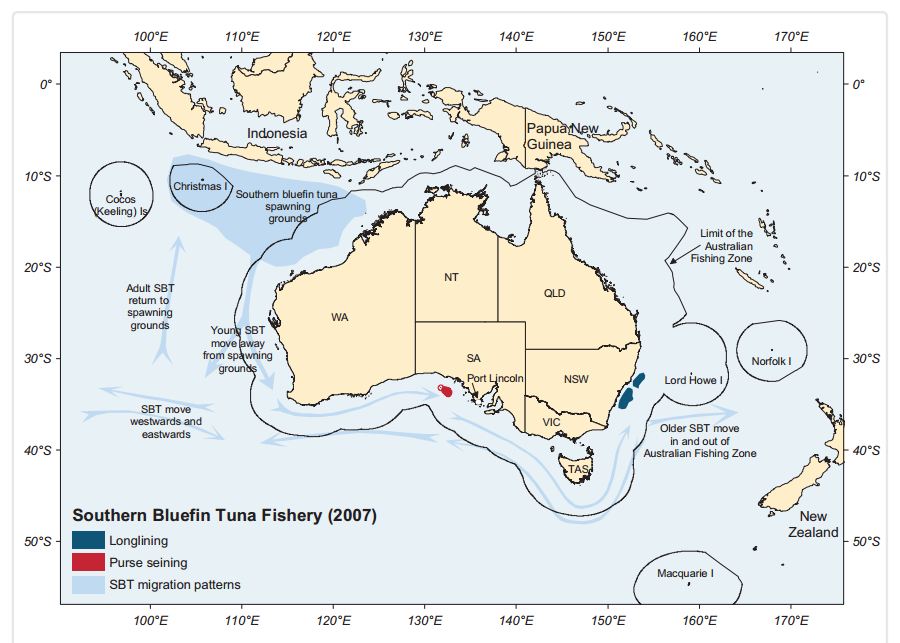Southern bluefin tuna has a mild to medium flavour.
Grilled or barbecued, tunas are best seared and left rare in the middle. Highlight with intense flavours such as charred capsicum, eggplant, balsamic vinegar and olive oil dressings.
Sashimi, carpaccio, or tartare blended with Atlantic salmon is ideal for tuna, married with dill, garlic, lemon and pepper.
Commercial catch limits
| Commercial catch limit | Fishing Mortality* | Biomass** |
|---|---|---|
Catch Limit 6,930 tonnes For the 2024–25 Season | G;Not subject to overfishing | G;Not overfished |
* Fishing mortality status relates to the level of fishing pressure on a stock – specifically, whether fishing mortality in the year being assessed is likely to result in the stock becoming overfished or prevent the stock from rebuilding from an overfished state. If fishing mortality exceeds either of these thresholds, a stock is considered to be subject to overfishing.
** Biomass status relates to how many fish there are – specifically, whether the biomass in the year being assessed is above the level at which the risk to the stock is considered to be unacceptable. The HSP defines this level as the limit reference point, below which the stock is considered to be overfished.
Scientific name: Thunnus maccoyii
Family: Scombridae
Other names: SBT
Description: Southern bluefin tuna have torpedo-shaped bodies with blackish-blue backs, and a silvery-white belly with alternating rows of clear dots and lines. The anal fin and finlets are yellow edged with black. The first dorsal fin has a yellow or blueish hue.
Size (length and weight): Up to 2.45 metres in length and 260 kg. Commonly found at 1.8 metres in length and 100 kg.
Life span: Up to at least 40 years.
Habitat: Southern bluefin tuna occur throughout the Atlantic, Pacific and Indian Oceans. Southern bluefin tuna are highly migratory and travel long distances. They are a pelagic species that can be found to depths of 500 metres. Southern bluefin tuna tend to school by size, and form large surface schools at certain times of the year. Juveniles are generally associated with coastal and continental shelf waters.
Prey: Fish, cephalopods, crustaceans and salps.
Predators: Marine mammals, billfish and other fish, sharks and seabirds feed on tuna at various states of the tuna’s life cycle.
Reproduction: Southern bluefin tuna reach reproductive maturity at 11–12 years of age. Spawning occurs in tropical waters during spring and summer. Only one spawning ground has been identified, in the north-eastern Indian Ocean south of Java. Females appear to spawn daily. It is not known whether all mature fish spawn each year, every few years, or even only once in their lifetime. Females produce 14–15 million eggs per spawning season. Southern bluefin tuna migrate southwards from the spawning ground after spawning.
Other notes: Southern bluefin tuna are classified as Endangered by the IUCN Red List of Threatened Species.
| Fishery found in | Gear used | Catch of this species is targeted or incidental |
|---|---|---|
| Southern Bluefin Tuna Fishery | Purse seine | Targeted |
| Eastern Tuna and Billfish Fishery | Pelagic longline | Targeted and incidental |
| Western Tuna and Billfish Fishery | Pelagic longline | Incidental |
| Recreational and other countries | Various | Targeted and incidental |
AFMA manages catches of southern bluefin tuna with a total allowable catch limit. This restricts the weight of fish that can be caught by each commercial fisher.
As southern bluefin tuna is a migratory species, it is also managed internationally. The international Commission for the Conservation of Southern Bluefin Tuna is made up of eight participating member countries, including Australia. The Commission sets an annual total allowable catch limit for each member country and AFMA applies Australia’s total allowable catch limit each year to our Southern Bluefin Tuna Fishery.
To further manage the Australian catches of southern bluefin tuna, commercial fishers are required to fill in records of their catches, during each fishing trip and when they land their catch in a port. AFMA also restricts the type and amount of gear that can be used to fish for southern bluefin tuna.
In Australian waters, southern bluefin tuna are found mainly in the Great Australian Bight. They are most commonly caught during the summer months (December to April), but they are also caught off the New South Wales coastline during winter.
Southern bluefin tuna is also caught recreationally in South Australia, Victoria, Tasmania and New South Wales. Recreational catches are managed by the state governments.

In Australia, commercial fishers mainly use purse seine nets to catch southern bluefin tuna. After being caught, these fish are towed closer inshore and transferred to permanent floating farms (pontoons). They stay in these farms for several months, where they grow bigger before being harvested and sold frozen, mainly to Japanese markets.
Longline fishing gear is used to catch southern bluefin tuna caught off the New South Wales coastline.
There are very low levels of bycatch caught in the Southern Bluefin Tuna Fishery, but some sharks and other species may be caught when fishing for southern bluefin tuna using longline gear.
Ecological risk assessments are done to find out if the fishing of southern bluefin tuna is harming other species. The most recent assessment was done in 2020 and the risk to other species was assessed as low.
Gear
Want to know more?
This is just an overview of southern bluefin tuna, if you want to know more see the links below.
This fish is managed under the Southern Bluefin Tuna Fishery.
- See the most recent Fishery status report
- Download raw data on annual catches from AFMA catch disposal records and AFMA daily fishing logbooks
- Southern Bluefin Tuna Management Advisory Committee
- Bycatch and discard program
- Southern Bluefin Tuna – Code of Practice Recreational Fishery
- Visit the FRDC Fishfiles website for the best cooking techniques and recipes for this fish